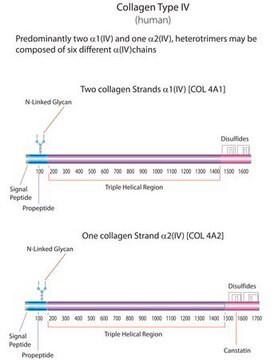CC050
Human Collagen Type I
from human placenta, liquid, 1 mg/mL, suitable for cell culture, used for gel formation
Sinônimo(s):
Human Collagen
About This Item
Produtos recomendados
product name
Human Collagen Type I,
fonte biológica
human
Nível de qualidade
Ensaio
>90% (collagen type I, SDS-PAGE)
forma
liquid
fabricante/nome comercial
Chemicon®
concentração
1 mg/mL
técnica(s)
cell culture | mammalian: suitable
Impurezas
<1% collagen type II,IV-VI & non-collagen proteins.
<10% collagen type III
entrada
sample type pancreatic stem cell(s)
sample type mesenchymal stem cell(s)
sample type epithelial cells
sample type induced pluripotent stem cell(s)
sample type neural stem cell(s)
sample type: human embryonic stem cell(s)
sample type hematopoietic stem cell(s)
solubilidade
water: soluble at 20 °C
nº de adesão NCBI
nº de adesão UniProt
Especificidade de ligação
Peptide Source: Elastin
Peptide Source: Fibronectin
Condições de expedição
dry ice
temperatura de armazenamento
−20°C
Informações sobre genes
human ... COL1A1(1277)
Categorias relacionadas
Descrição geral
Aplicação
- as a control in the 2B4 nuclear factor of activated T-cells (NFAT)–GFP reporter cell assay, where its interaction with reporter cells can be evaluated for nuclear factor of activated T-cells (NFAT) promoter-driven GFP expression
- for coating glass slides in dynamic binding assays to create a substrate for the specific binding and study of platelets and conjugates in flow channels
- as a protein standard in histological analysis of lung tissue samples, providing a reference for the composition and characterization of extracellular matrix (ECM) components
Ações bioquímicas/fisiológicas
forma física
Nota de análise
Informações legais
Exoneração de responsabilidade
Código de classe de armazenamento
12 - Non Combustible Liquids
Classe de risco de água (WGK)
WGK 1
Ponto de fulgor (°F)
Not applicable
Ponto de fulgor (°C)
Not applicable
Certificados de análise (COA)
Busque Certificados de análise (COA) digitando o Número do Lote do produto. Os números de lote e remessa podem ser encontrados no rótulo de um produto após a palavra “Lot” ou “Batch”.
Já possui este produto?
Encontre a documentação dos produtos que você adquiriu recentemente na biblioteca de documentos.
Os clientes também visualizaram
Artigos
Extracellular matrix proteins such as laminin, collagen, and fibronectin can be used as cell attachment substrates in cell culture.
Protocolos
This page covers the ECM coating protocols developed for four types of ECMs on Millicell®-CM inserts, Collagen Type 1, Fibronectin, Laminin, and Matrigel.
Nossa equipe de cientistas tem experiência em todas as áreas de pesquisa, incluindo Life Sciences, ciência de materiais, síntese química, cromatografia, química analítica e muitas outras.
Entre em contato com a assistência técnica









